LEYTONSTONE.
ART AND HISTORY SITES ON FREE PUBLIC VIEW
| Various suggestions have been made for the origin of the name Wanstead. 'Stead' seems to come from the Old English 'stede' meaning 'place' or 'house of'; but 'Wan' has been suggested as being (a) wan meaning white (b) 'wen' meaning a hill (c) 'waen' meaning a wagon (as in Constable's 'Haywain') (d) Shortened form of Woden, the Norse God. Wanstead is mentioned in the Domesday Book as a manor previously held by St Paul (later known as St Paul's Cathedral) but at the time of the survey belonging to Ranulf Fitz Brien. It was described as having a manor house, a large area of woodland and one mill. For the origin of Leytonstone see Leyton Stone |
PUT MOUSE OVER  TO READ NAME
TO READ NAME
CLICK ON  FOR PHOTO & EXPLANATION.
FOR PHOTO & EXPLANATION.
CONTENTS1. "Allum" 2. Blue Sculpture 3. Cattle Grid 4. Church Sculptures 5. Drinking Fountain 6. Eagle on the Roof 7. Forest Primary School Mural 8. Giant's Head 9. Hitchchcock Gallery 10. Langthorne Park Mosaic & Screen 11. "Leaf Memory" 12. Leyton Stone 13. Leytonstone House 14. Lion Gateway 15. Little Green Men 16. "The Loaded Dog" 17. Sir Morell Mackenzie 18.Marine Murals 19. "Music" 20. Parish Boundary Stone 1 21. Parish Boundary Marker 2 22. "The Pastures" 23. "Sea Bass" 24. "Time Terminus" 25. Totem Pole 26. "Touch of the Green Man" 27. Whipps Cross Cat | |
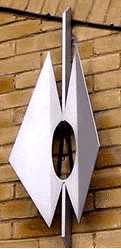 |
"Allum." |
||||||||||||||
Allum Medical Centre, Fairlop Road, next to the church. This is an aluminium sculpture on the front wall of the building. (See No. 1. on Map ) Sculptor: Jack Gardner. 1992. (See also "Lotus", "Tao Column" and "Fleeing Woman" by the same artist.) |
|||||||||||||||
 |
Blue Sculpture |
||||||||||||||
Blue sculpture just inside the northern entrance to Langthorne Park. (See No. 2. on Map ) |
|||||||||||||||
 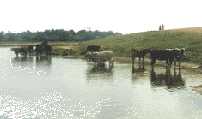 |
Cattle Grid. | ||||||||||||||
On the slip road leading from the Green Man Roundabout onto the A12. Since 1630, the tenants of the manors of Wanstead, Aldersbrook, Leyton and Ruckholt had the right to pasture their horses and cattle in the open places in the forest. This continued after the areas became suburbs of London. Until the outbreak of foot and mouth disease in the late 1990s, cattle were often responsible for delaying traffic on the Green Man Roundabout and the surrounding roads. When the new road was put in (c. 1993) it was necessary to install a grid to stop them wandering onto the busy two lane road. Planners must have thought that the cattle would observe the rules of the road, as they did not bother to install a grid on the slip road leading off the A12. The lower photo taken in 1991 shows cattle drinking from the pond on Wanstead Flats called Alexandra Lake. (See No. 3. on Map ) |
|||||||||||||||
 |
Church Sculptures. | ||||||||||||||
Three of a group of five sculptures over the door of Church of the Holy Trinity with St Augustine of Hippo almost opposite Melon Road. (See No. 4. on Map ) |
|||||||||||||||
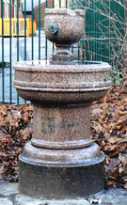 |
Drinking Fountain. | ||||||||||||||
At the end of Davies Lane. Put up by the Metropolitan Drinking Fountain and Cattle Trough Association right outside Davies Lane School. Originally, water came out of two spouts when buttons were pushed. But it no longer works (2007). (See No. 5. on Map ) |
|||||||||||||||
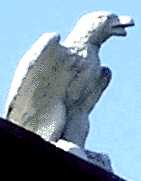 |
Eagle on the Roof. | ||||||||||||||
Perched permanently on the roof of 101 Whipps Cross Road, which is on the corner of Preston Road. This eagle glares down disapprovingly on the stream of traffic passing below. (See No. 6. on Map ) |
|||||||||||||||
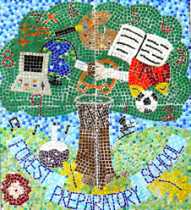 |
Forest Preparatory School Mosaic. |
||||||||||||||
Mosaic on the front of the school buildings in Oakhurst Gardens. This is possibly the first mosaic to show a laptop computer. In front of this mosaic there stands what looks to be a litter bin designed in the shape of a large blue crayon. (See No. 7. on Map ) Designed by pupils of the school Date: 2007. | |||||||||||||||
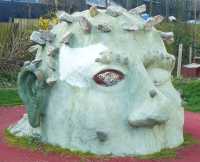 |
Giant's Head. |
||||||||||||||
In the Acacia Road Play Park on the corner of Montague Road and Acacia Road. The head is about two metres high and was constructed at the Eden Project in Cornwall. He originally had green grass hair and two eyes. But the grass died during a hot summer and one eye was damaged so now winks. There are other interesting artworks in play park. Look out for mosaics, some beautiful wrought iron gates and a cement path decorated by childrens' hand prints. (See No. 8. on Map ) Sculptor: Peter Hill. |
|||||||||||||||
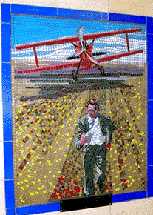 |
Hitchcock Gallery. | ||||||||||||||
In the underpass leading to Leytonstone underground station. There is a series of 17 mosaics showing scenes from the films made by Alfred Hitchcock. Hitchcock was born nearby at 517 Leytonstone High Street in 1899. One mosaic shows him helping his father in the shop the family owned. The panel illustrated is from North by North West made in 1959. The hero is being chased by a crop-spraying aircraft. The mosaics were designed and made by a team of artists whose names were: Steve and Nathan Lobb, Carol Kenna, Claire Notley and Julie Norburn. (See No. 9. on Map ) | |||||||||||||||
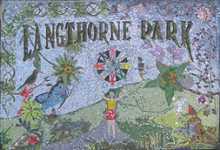  |
Langthorne Park Mosaic & Screen. | ||||||||||||||
High Road Leytonstone. On the site of the old Langthorne Hospital there is a new park. The whole area has been landscaped including the internet caf� by this entrance. The name Lanthorne was chosen because this site was once owned by Stratford Langthorne Abbey. This mosaic is beside the internet caf� and is visible from the High Road. Also illustrated is one of two decorates screens which are situated close by (See No. 10. on Map ) Mosaic Artist: Stewart Hale. |
|||||||||||||||
 |
"Leaf Memory" | ||||||||||||||
Where Grove Road should meet Leytonstone High Road and the road is blocked off. This half human figure covered in leaves and tinged with green is clearly linked with the Green Man Roundabout which is at the end of the High Road. For more about the Green Man and his legends see "Touch of the Green Man". (See No. 11. on Map ) Sculptor: Stephen Duncan. |
|||||||||||||||
 |
Leyton Stone. | ||||||||||||||
At the junction of Hollybush Hill and New Wanstead. A stone like this has been shown here on maps since at least 1774, but it was thought to be much older and may date back to the Roman period. It is probably the stone in the name of Leytonstone. In 1370 the village was referred to as Leyton-atte-Stone. The upright stone has been replaced but the base is very old. In recent times the upper stone has served as a tall signpost or milestone and the now shows which road to follow when leaving London:
|
|||||||||||||||
 |
Leytonstone House. | ||||||||||||||
Leytonstone High Road by the Green Man Roundabout, behind Tescos. Built about 1800, This was the home of Sir Edward North Buxton (1812-1858) one of a philanthropic family of brewers. His father Thomas Fowell Buxton (1786-1845) had helped both Elizabeth Fry in her work for prison reform and William Wilberforce in his fight to end slavery. Edward was member of Parliament for South Essex and married Elizabeth the daughter of Elizabeth Fry. Two of their sons, Thomas and Edward played a large part in the introduction of the Epping Forest Act of 1878, which protected the forest itself from encroachment and also the rights of the commoners to use it. (See No. 13. on Map ) |
|||||||||||||||
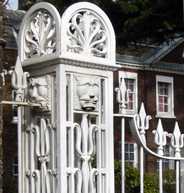 |
Lion Gateway. |
||||||||||||||
Oakhurst Gardens. In front of Forest School founded in 1834 is occupying a large house built in the 18th century. These elaborate cast iron railings with lions heads on the gateposts may well date back to the 18th century. These are indeed rare examples of such work as most old railings were cut down in world war II and melted down for the production of armaments and munitions. (See No. 14. on Map ) | |||||||||||||||
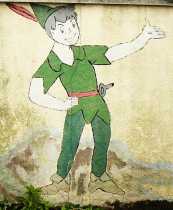 |
"Little Green Men." |
||||||||||||||
This is the name of the nursery school on the corner of Gainsborough Road and Lemna Road. This little green man has been painted on the front garden wall, but is no relation to the other Green Men of Leytonstone, as he is better known as Peter Pan and he is accompanied here by Captain Hook and the crocodile. .15. on Map ) |
|||||||||||||||
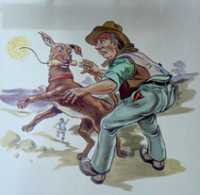 |
"The Loaded Dog." | ||||||||||||||
Leytonstone High Road. Pub sign of the Loaded Dog Public House. This picture is probably based on a 19th century story from Wales with the same title, telling how a miner tried out an easy way to catch a lot of fish. He threw a stick of dynamite into a river expecting the explosion to kill or stun the fish. However, his faithful but dim dog dashed in and retrieved it, returning with a wagging tail and the dynamite in its mouth. The dog's tail did not wag much longer. The term was also used on greyhound race tracks, where dogs were sometimes loaded with weights to lose, as opposed to loaded dice which were tampered with to win.16. on Map ) |
|||||||||||||||
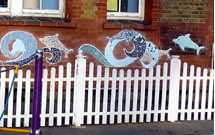 |
Marine Murals. | ||||||||||||||
Davies Lane, A section of the brightly coloured mural on the front and side of Davies Lane School. (See No. 17. on Map ) |
|||||||||||||||
 |
Sir Morell Mackenzie. | ||||||||||||||
Plaque on the wall of the house on the corner of Browning Road and High Street Leytonstone. Sir Morell Mackenzie (1837-1892) worked at the London Hospital and specialised in conditions of the throat and nose. His work and writings paved the way for modern diagnosis and treatment of diseases of the larynx. (See No. 18. on Map ) |
|||||||||||||||
 |
"Music". | ||||||||||||||
Inside Langthorne Park, off High Road Leytonstone. There is an open-air arena with tiered seating. On the two ends of the arc of seats are two roundels. This one represents Music and the other represents Dance. (See No. 19 . on Map ) |
|||||||||||||||
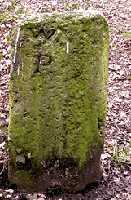 |
Parish Boundary Stone 1. | ||||||||||||||
In the woods 100 yards south of Eagle Pond and just inside the perimeter fence. This stone marked the border of the Walthamstow Slip, a narrow strip of land about 3 miles long and about 50 yards wide, which used to belong to Walthamstow and protruded into Leytonstone (shown approximately by the shaded area on the map). In the twelfth century those living within the slip paid their tithes to Wathamstow parish. This anomaly was removed in 1885. The W P carved on the stone stand for Walthamstow Parish. There is an unsubstantiated story of the origin of the strip. It states that a man's body was found in Epping Forest. Normally the parish was responsible for burying such corpses, but Leytonstone refused to do so. Walthamstow parish did so instead and so claimed the land where the corpse was. It goes on to say that ten parishioners with outstretched arms joined hands at the place where the corpse lay and then walked towards the Walthamstow boundary and all the ground covered became part of Walthamstow. This is a myth as it would have been impossible to walk like that through a dense forest. More likely is the fact that it was quite common for parishes to own land outside their normal borders. Another example of this was North Woolwich. (See No. 20. on Map ) |
|||||||||||||||
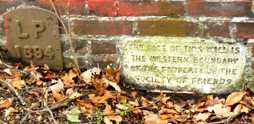 |
Parish Boundary Marker 2. | ||||||||||||||
On the outside wall surrounding the Friends meeting House in Bush Road. The letters LP on the left hand marker stand for Leytonstone Parish. Next to it is a stone saying: THE FACE OF THIS WALL IS THE WESTERN BOUNDARY OF THE PROPERTY OF THE SOCIETY OF FRIENDS. JULY 1894. There are similar inscribed stones on the south and east walls of the property. Colloquially known as the Quakers, the Society of Friends and their nickname date back to the 17th century. The prejudice and persecution they initially experienced, led to the Pilgrim Fathers sailing to the Americas in the "Mayflower" in 1620. The Friends Meeting House established here was more than two centuries later. There was an earlier Friends Meeting House in East London. (See No. 21. on Map ) |
|||||||||||||||
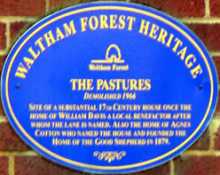 |
"The Pastures" |
||||||||||||||
Visible from Davies Lane. This blue plaque fixed to the front of Youth Centre records the fact that a large house known as "The Pastures" stood here 17th to the 20th century and was pulled down in 1966. In 1833, William Davis, who lived there, donated 5 of the present 8 bells in Leytonstone Parish Church. Davies Lane, despite the different spelling, is named after him. (See No. 22. on Map ) |
|||||||||||||||
 |
"Sea Bass." |
||||||||||||||
Harrow Road. A 10 metre long boat labelled Sea Bass in the play area in Harrow Road Park. Two slides have been fixed and a mock canon pokes out of one side. There is a series of sculptures with marine themes on the ground in front of its bow. (See No. 23. on Map ) |
|||||||||||||||
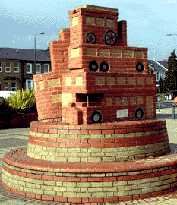 |
"Time Terminus." | ||||||||||||||
In the bus terminus in Grove Green Road, outside the Leytonstone Underground Station. The sculpture composed of building bricks shaped to depict buses both new and old. It has a double function for the base provides a circular seat for people waiting for buses. (See No. 24. on Map ) Sculptor: Lodewyk Pretor. 1999. |
|||||||||||||||
 |
"Totem Pole" | ||||||||||||||
Langhthorne Park in the picnic area near the northern entrance. The pole stands about 3 or 4 metres high. (See No. 25. on Map ) Sculptor: Robert Koenig. |
|||||||||||||||
 |
"The Touch Of The Green Man." | ||||||||||||||
Situated at the End of Bush Road by Green Man Roundabout. Depicting a green man holding the sun and moon. On the left is a stone obelisk. This obelisk now stands about 400 yards to the north of the mosaic. (See Leyton Stone. ) The Green Man was the name of a series of pubs on this site since 1668, before the last one was unfortunately renamed O'Niels. In 1726, Daniel Defoe describes it as a well established inn. It is sad that a name used for some three centuries has been discarded and is now only remembered by this mosaic and by the name of a modern roundabout. It is said that in the 18th century, the highway robber Dick Turpin and other highway men often stayed here in a room fitted out with a large chest. The chest had a false bottom which was a trap-door leading to an escape route, to be used in an emergency. The origin of the name Green Man is far from certain. He appeared in Roman times as a figure that was half human half vegetation. Later in Britain, he was apparently a pagan deity representing the spirits of trees and was linked with the festival of Beltane on May 1st, marking the coming of Spring and the trees turning green. This led to him being called Green George or Jack-in-the-Green. He was somehow assimilated into the mediaeval church and can be found in some churches from the 12th century onwards. However, the pub's name may also have originated from the green-clad forest wardens in the neighbouring Epping Forest. See "Leaf Memory" for another interpretation of the legend For the artist's own concepts of this work Click Here. (See No. 26. on Map ) Designer: Nuala Flynn. Date 2000. |
|||||||||||||||
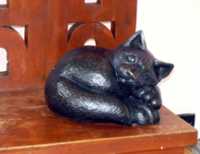 |
Whipps Cross Cat | ||||||||||||||
Whipps Cross Hospital. Near junction 5 of the long corridor. This cat has been lying curled up on his bench for some years now. He is sleeping there with one wary eye open looking at all who pass by. He is just one of many artworks which brighten up the hospital. They are not listed here as they are frequently changed. The length of the long corridor is nearly a quarter of a mile. (See No. 27. on Map ) |
|||||||||||||||
OTHER AREAS COVERED:-
|| Beckton || Bethnal Green || Blackwall || Bow || Bromley-by-Bow || Canary Wharf || Canning Town || Chingford || Cubit Town || Custom House || East Ham || East India Dock || Forest Gate || Higham's Park || Leyton || Limehouse || Little Ilford || Manor Park || Mile End || Millwall || North Woolwich || Plaistow || Plashet || Poplar || St George's || St Katharine Dock || Shadwell || Shoreditch || Silvertown || Snaresbrook || Spitalfields || Stepney || Stratford || Upton || Walthamstow East || Walthamstow Village || Walthamstow West || Wanstead || Wapping || West India Dock || Whitechapel || Woodford || |